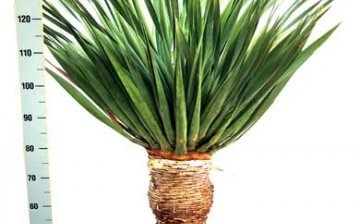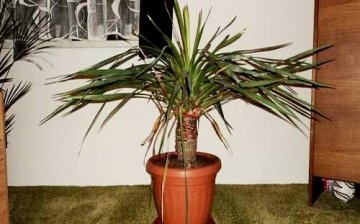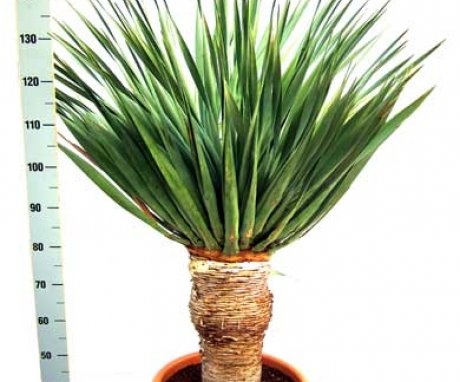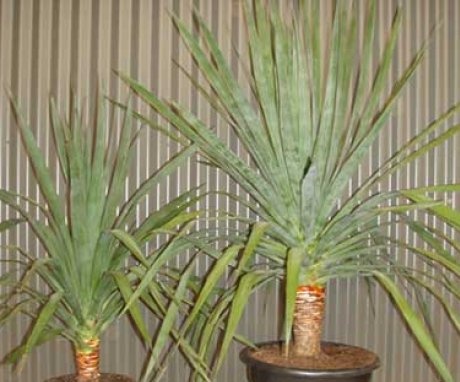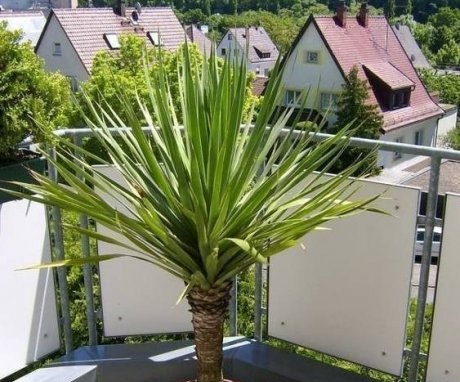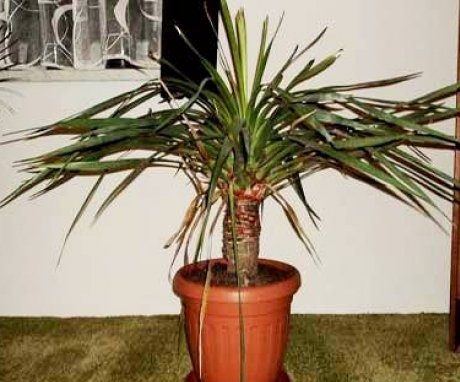Dracaena Dragon: description and rules of cultivation
Dracaena is one of the most popular indoor plants. They are often placed in offices and purchased as a gift. Dracaena is famous for its unpretentiousness, endurance, as well as its unusual appearance, reminiscent of a bonsai. Dracaena Dragon has an unusual appearance due to the green, slightly reddish shade of leathery leaves. This type of Dracen is especially unpretentious.
Content:
- Description of the plant
- Dates of reproduction, planting and transplant of Dracaena
- Houseplant care
- Diseases and pests
Description of the plant
Dracaena belongs to the Asparagus family and grows in the wild in Central America, Africa, and southern Asia. Under natural conditions, Dracaena Dragon reaches enormous sizes, its height can reach 20 m. At home, this plant is not higher than 1.5 m. Dracaena is also called the Dragon tree. The very name "dracaena" is consonant with a dragon. Dracaena Dragon is sometimes translated as "female dragon". All this is due to the appearance of the plant, as well as a large number of legends.
Dracaena Dragon has leathery dense elongated leaves of a dark green color. In bright light, the leaves give off a reddish color. Also, the juice of this plant has a reddish tint, which gave rise to the legends of dragon blood. The plant has a dense trunk, the leaves are collected in bunches at the top of the trunk. As it grows, the trunk branches out.
Dracaena Dragon is loved by flower growers for its special unpretentiousness, unlike other types of Dracaena, this plant grows well both in warm and cool rooms.
In natural conditions, the Dragon tree lives for a very long time. Some scientists estimate several thousand years. In indoor conditions, the lifespan of a plant largely depends on care. Dracaena Dragon blooms with beautiful white flowers, which then turn into red fruits. But this is rarely seen. In the wild, this plant blooms about once every 15 years.
There are many legends and superstitions around this plant. One of them is associated with a dragon named Frankincense. He lived in a garden with wonderful rejuvenating apples. To get these apples, Hercules, on the orders of the Mycenaean prince, kills the dragon. His blood irrigates the grounds of the garden, and where her drops have fallen, mighty trees grow, as strong as the dragon himself. It is believed that dracaena helps protect against negative energy and also brings good luck in love. According to legend, a young man who dreamed of getting married watered a stick every day, and leaves appeared on it on the 5th day. After which the father of his beloved was obliged to give his daughter to him as a wife. Therefore, a twig of Dracaena cut at midnight is considered a love amulet.
Dates of reproduction, planting and transplant of Dracaena
Reproduction and transplantation of Dracaena Dragon has its own characteristics. You can propagate the plant seeds or cuttings... However, you can wait for seeds for a very long time, but getting a stalk is much easier.
Subject to certain rules for planting and transplanting Dracaena, you can carry out these procedures without harm to the plant:
- Reproduction may also be needed to rejuvenate the plant. When Dracaena is stretched, the lower part of its trunk sheds leaves, which affects the appearance of the plant. Transfer it is needed if the old pot has become cramped.It is advisable to replant young Dracena annually.
- Reproduction, like transplanting, is best done in the spring, in March or April. At this time, the procedure will be the least traumatic for the plant. A transplant at other times of the year is also possible, but it will be more difficult for Dracena to take root, and special care will be needed.
Dracaena breeding features:
- To propagate a plant, you need to cut off one of its tops with leaves.
- The length of such a handle should be at least 15 cm.
- In this case, you need to cut off the stem with a sharp knife, not allowing the trunk to be cut, otherwise it will soften and rooting will be poor.
- The cut off stalk can be immediately planted in the ground or kept in water for some time. A properly cut stalk takes root well.
- Despite the fact that Dracaena takes root quickly, when planting it, it is advisable to use special preparations that stimulate the appearance of roots.
After planting the cuttings, it is necessary to create greenhouse conditions for the plant. Good watering is essential. It is advisable to cover the stalk with a piece of a plastic bottle or just put it in a warm, bright place.
Transplanting an adult dracaena requires caution.
Despite the fact that the plant itself grows rather slowly, it root system develops intensively. When transplanting, you can see that the roots have filled the entire pot, displacing the earth. For this reason, you need to regularly transplant the flower into a deeper pot.
The transplant procedure itself is quite simple. You need to buy a special land for Dracaena. Drainage is placed at the bottom of the pot, then part of the earth. After that, a plant is placed in a pot and carefully sprinkled with earth on top.
Houseplant care
Dracaena Dragon is known for its unpretentiousness. However, if you want to grow a healthy, strong plant, you need to create certain conditions for it. Dracaena care:
- Dracaena Dragon loves warmth, but grows well in coolness. In summer, a comfortable temperature is considered to be at least 20 degrees, in winter - at least 15, but without drafts. However, in the sun it is necessary to protect the leaves of Dracaena from the scorching sun.
- The soil for Dracaena can be prepared independently from turf, sand, peat and humus. Don't forget about drainage.
- Dracaena Dragon loves light, but not direct sunlight. It is best to choose a west or east window for it. He also tolerates partial shade well. In winter, you can use artificial lighting.
- It is advisable to spray the flower in winter and wipe the leaves from dust regularly. Dracaena Dragon tolerates dry air, but will grow better with sufficient moisture.
- Dracaena likes regular watering... In the summer, in the heat, it is recommended to water it daily in the morning. The soil in the pot should always be slightly damp, but free of puddles and dirt. If the water stagnates, this will lead to decay of the roots, and at low temperatures, it will completely destroy the plant. In winter, it is not necessary to water the flower daily, it is enough to make sure that the earthy clod does not dry out.
- During the growth period, Dracena needs to be fed with fertilizers. From about March to August, feeding should be regular. Any complex fertilizers for variegated plants.
- It is advisable to loosen the topsoil periodically. This will allow the oxygen to penetrate deeper into the soil and will also improve moisture penetration to the roots. You need to loosen the top layer, shallowly and very carefully, as you can damage the overgrown roots of Dracaena.
- Dracaena needs to be pruned regularly so that it branches and looks more luxuriant. Without trimming, the trunk grows upward and looks bare. Pruning must be produced in the spring. Cutting points are marked in advance. You need to cut it off carefully, with a sharp knife. After the procedure, the cut sites are sprinkled with charcoal.
Diseases and pests
Dracaena Dragon is not often sick, but it can be affected by other indoor plants or get sick with improper care.
As a rule, Dracaena diseases and pests are standard for all indoor flowers:
- Spider mite. This pest often infects indoor plants. The spider mite eats the leaves of plants, entangling them with a thin cobweb. This parasite can appear in dry rooms in the absence of adequate air humidity. It is very difficult to get rid of a spider mite, as its eggs can remain in the ground for up to 5 years and mature constantly. You can deal with it with purchased means or folk methods: decoction of orange peels, juice garlic.
- The leaves turn yellow. If the leaves on the flower begin to turn yellow and dry out, then it lacks nutrients and most likely nitrogen. You can solve this problem with mineral fertilizers... Also, the leaves on Dracaena dry out from lack of heat.
- The leaves turn black. Leaves may turn black due to hypothermia. If the temperature in the room is too low for the flower, there are drafts and black spots appear on the tips of the leaves. It can also be due to insufficient watering or too dry indoor air.
- Shields. These are small and inactive pests resembling aphids with a small shell. Scabbards suck sap from the plant, as a result of which it dries up and dies. Black spots or holes appear on the leaves. The scale insects themselves are very easy to confuse with specks, since they are motionless and no more than 5 mm in size. A mechanical method, as well as the use of insecticides, will help get rid of these pests.
- Thrips. Thrips have an elongated body and are able to move quickly. These pests are very small and difficult to see. The plant affected by thrips begins to shed its leaves. But first, yellow bubbles appear on them, which turn into holes. To get rid of thrips, you need to thoroughly rinse the plant in the shower, and then treat it with an insecticide.
With proper care and timely prevention, these diseases can be avoided. Infectious diseases in Dracaena are rare, much more often they are of a non-infectious nature and are the result of non-compliance with the rules of care.
More information can be found in the video:




